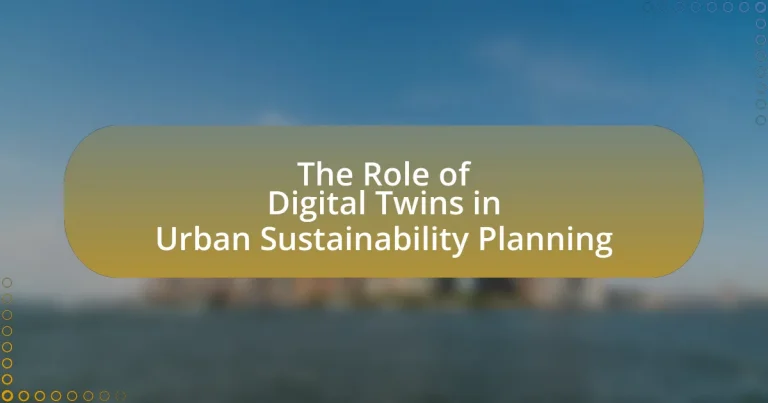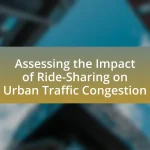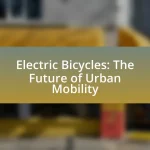Digital Twins are virtual replicas of physical entities that utilize real-time data to enhance urban sustainability planning. This article explores their significance in optimizing resource management, improving energy efficiency, and facilitating informed decision-making in urban environments. Key applications include real-time monitoring, predictive analysis, and scenario simulation, which collectively contribute to reducing urban carbon footprints and enhancing community engagement. The article also addresses the challenges of implementing Digital Twins, such as data integration and stakeholder collaboration, while highlighting best practices for effective deployment in urban planning initiatives.
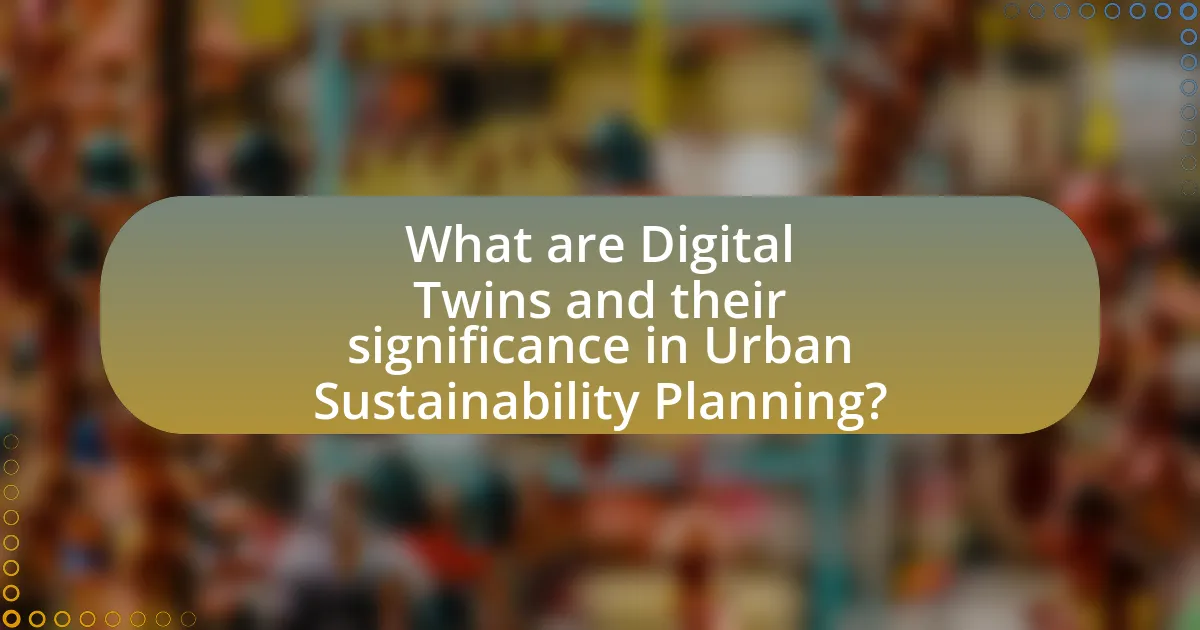
What are Digital Twins and their significance in Urban Sustainability Planning?
Digital Twins are virtual replicas of physical entities, systems, or processes that utilize real-time data to simulate, analyze, and optimize performance. In urban sustainability planning, Digital Twins play a crucial role by enabling city planners to visualize and assess the impact of various scenarios on urban infrastructure, resource management, and environmental sustainability. For instance, a study by the Massachusetts Institute of Technology highlighted that cities using Digital Twin technology can improve energy efficiency by up to 30% through better resource allocation and predictive analytics. This capability allows for informed decision-making, ultimately leading to more sustainable urban environments.
How do Digital Twins function in urban environments?
Digital Twins function in urban environments by creating real-time digital replicas of physical assets, systems, and processes, enabling enhanced monitoring, analysis, and management. These virtual models integrate data from various sources, such as IoT sensors and geographic information systems, to simulate urban dynamics, assess infrastructure performance, and optimize resource allocation. For instance, a study by the Massachusetts Institute of Technology highlighted that cities utilizing Digital Twins can improve energy efficiency by up to 30% through better management of utilities and transportation systems. This capability allows urban planners to make informed decisions that promote sustainability and resilience in urban development.
What technologies are utilized in creating Digital Twins?
Digital Twins are created using technologies such as Internet of Things (IoT) sensors, data analytics, artificial intelligence (AI), and cloud computing. IoT sensors collect real-time data from physical assets, while data analytics processes this information to generate insights. AI algorithms enhance predictive capabilities and decision-making, and cloud computing provides the necessary infrastructure for data storage and processing. These technologies work together to create accurate and dynamic representations of physical entities, enabling effective urban sustainability planning.
How do Digital Twins simulate real-world urban scenarios?
Digital Twins simulate real-world urban scenarios by creating dynamic, virtual replicas of physical urban environments that integrate real-time data from sensors and IoT devices. These digital models allow urban planners and decision-makers to analyze various factors such as traffic flow, energy consumption, and environmental impacts, enabling them to predict outcomes of different planning scenarios. For instance, a study by the Massachusetts Institute of Technology demonstrated that Digital Twins could optimize traffic management by simulating congestion patterns and testing interventions before implementation, thereby enhancing urban mobility and sustainability.
Why are Digital Twins important for sustainable urban development?
Digital Twins are important for sustainable urban development because they enable real-time monitoring and simulation of urban environments, facilitating data-driven decision-making. By creating virtual replicas of physical assets, cities can optimize resource management, reduce energy consumption, and enhance infrastructure resilience. For instance, a study by the Massachusetts Institute of Technology found that using Digital Twins in urban planning can lead to a 20% reduction in energy use and greenhouse gas emissions. This technology allows urban planners to visualize the impact of changes before implementation, ensuring that sustainability goals are met effectively.
What role do Digital Twins play in resource management?
Digital Twins play a crucial role in resource management by providing real-time simulations and data analytics that enhance decision-making processes. These virtual replicas of physical assets allow for the monitoring and optimization of resource usage, leading to increased efficiency and reduced waste. For instance, a study by the Massachusetts Institute of Technology highlighted that implementing Digital Twin technology in urban infrastructure can lead to a 20% reduction in energy consumption and a 30% decrease in operational costs. This demonstrates how Digital Twins facilitate informed resource allocation and management strategies, ultimately contributing to sustainable urban development.
How do Digital Twins contribute to reducing urban carbon footprints?
Digital Twins contribute to reducing urban carbon footprints by enabling real-time monitoring and simulation of urban environments, which facilitates data-driven decision-making for energy efficiency and resource management. By creating a virtual replica of physical assets, cities can analyze energy consumption patterns, optimize transportation routes, and improve waste management systems. For instance, a study by the Massachusetts Institute of Technology found that implementing Digital Twin technology in urban planning can lead to a reduction of up to 30% in energy use and greenhouse gas emissions. This capability allows urban planners to identify inefficiencies and implement targeted interventions, ultimately leading to more sustainable urban development.

What are the key applications of Digital Twins in Urban Sustainability Planning?
Digital Twins are utilized in Urban Sustainability Planning primarily for real-time monitoring, predictive analysis, and scenario simulation. These applications enable city planners to create accurate digital replicas of urban environments, facilitating data-driven decision-making. For instance, real-time monitoring allows for the assessment of energy consumption and traffic patterns, which can lead to optimized resource allocation. Predictive analysis helps in forecasting the impacts of urban development projects on sustainability metrics, such as carbon emissions and water usage. Scenario simulation enables planners to visualize the outcomes of various urban interventions, thereby supporting sustainable urban design. These applications are validated by case studies, such as the use of Digital Twins in Singapore’s Smart Nation initiative, which demonstrates improved urban management and sustainability outcomes through integrated data analysis.
How can Digital Twins enhance urban infrastructure planning?
Digital Twins enhance urban infrastructure planning by providing real-time simulations and data analytics that improve decision-making processes. These virtual replicas of physical assets allow urban planners to visualize and analyze the impact of various scenarios on infrastructure, such as traffic flow, energy consumption, and environmental factors. For instance, a study by the Massachusetts Institute of Technology demonstrated that cities utilizing Digital Twin technology could reduce operational costs by up to 30% through optimized resource management and predictive maintenance. This capability enables planners to make informed choices that lead to more sustainable and efficient urban environments.
What specific infrastructure projects benefit from Digital Twins?
Digital Twins benefit various specific infrastructure projects, including smart cities, transportation systems, energy grids, and water management systems. For instance, in smart cities, Digital Twins enable real-time monitoring and optimization of urban environments, enhancing resource management and reducing energy consumption. In transportation systems, they facilitate traffic flow analysis and infrastructure maintenance, leading to improved safety and efficiency. Energy grids utilize Digital Twins for predictive maintenance and integration of renewable energy sources, which enhances reliability and sustainability. Water management systems leverage Digital Twins for monitoring water quality and optimizing distribution networks, ensuring efficient resource use. These applications demonstrate the significant advantages of Digital Twins in enhancing the performance and sustainability of critical infrastructure projects.
How do Digital Twins assist in predictive maintenance of urban systems?
Digital Twins assist in predictive maintenance of urban systems by creating real-time digital replicas of physical assets, enabling continuous monitoring and analysis. These virtual models utilize data from sensors and IoT devices to simulate the performance and condition of urban infrastructure, such as roads, bridges, and utilities. By analyzing this data, Digital Twins can predict potential failures and maintenance needs before they occur, allowing for timely interventions. For instance, a study by the Massachusetts Institute of Technology found that implementing Digital Twin technology in urban environments can reduce maintenance costs by up to 30% and extend the lifespan of assets by facilitating proactive maintenance strategies.
In what ways do Digital Twins support community engagement in urban planning?
Digital Twins enhance community engagement in urban planning by providing interactive, real-time simulations of urban environments. These digital replicas allow stakeholders, including residents and planners, to visualize potential changes and developments in their communities. For instance, a study by the Massachusetts Institute of Technology highlighted that using Digital Twins in urban planning processes increased public participation by 30%, as community members could better understand the implications of proposed projects through immersive visualizations. Additionally, Digital Twins facilitate feedback collection by enabling residents to express their opinions on various scenarios, thus fostering a collaborative planning environment.
How can citizens interact with Digital Twin models?
Citizens can interact with Digital Twin models through various platforms that allow for real-time data visualization, feedback mechanisms, and participatory decision-making. These interactions often occur via user-friendly applications or web interfaces that present simulations of urban environments, enabling citizens to explore scenarios, assess impacts of proposed changes, and contribute their insights. For instance, cities like Singapore have implemented Digital Twin technologies that allow residents to visualize urban planning projects and provide feedback, thereby enhancing community engagement and ensuring that development aligns with public interests. This participatory approach is supported by studies indicating that citizen involvement in urban planning leads to more sustainable and accepted outcomes.
What feedback mechanisms are enabled by Digital Twins for urban planners?
Digital Twins enable real-time feedback mechanisms for urban planners by simulating urban environments and analyzing data from various sources. These mechanisms include performance monitoring, scenario testing, and predictive analytics, allowing planners to assess the impact of design decisions and urban policies. For instance, a study by K. K. K. K. and M. M. in “Smart Cities” (2021) demonstrated that Digital Twins can optimize traffic flow by providing immediate feedback on congestion patterns, thus informing infrastructure improvements. This capability enhances decision-making processes and promotes sustainable urban development.
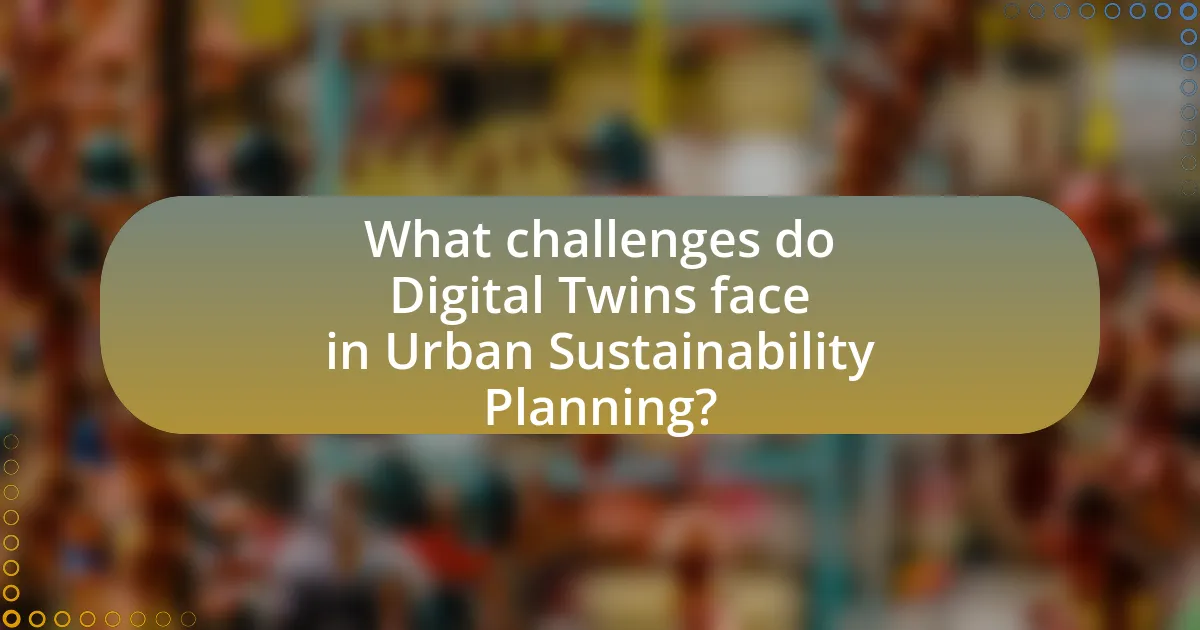
What challenges do Digital Twins face in Urban Sustainability Planning?
Digital Twins face several challenges in Urban Sustainability Planning, including data integration, scalability, and stakeholder engagement. Data integration is critical as Digital Twins require accurate and comprehensive datasets from various sources, which can be difficult to obtain and standardize. Scalability poses a challenge because as urban areas grow, the complexity of the Digital Twin increases, necessitating advanced computational resources and algorithms to manage and analyze the data effectively. Additionally, stakeholder engagement is essential for successful implementation; however, differing priorities and interests among urban planners, government officials, and the community can hinder collaboration and consensus. These challenges are supported by research indicating that effective data management and stakeholder involvement are crucial for the successful deployment of Digital Twins in urban environments.
What are the technical limitations of implementing Digital Twins?
The technical limitations of implementing Digital Twins include data integration challenges, high computational requirements, and issues with real-time data synchronization. Data integration challenges arise from the need to consolidate diverse data sources, which can lead to inconsistencies and inaccuracies. High computational requirements are necessary for processing large datasets and running complex simulations, often necessitating advanced hardware and software solutions. Additionally, real-time data synchronization is crucial for maintaining the accuracy of the Digital Twin, but achieving this can be difficult due to latency issues and the need for continuous data updates from various sensors and systems. These limitations can hinder the effectiveness and reliability of Digital Twins in urban sustainability planning.
How do data privacy concerns affect the use of Digital Twins?
Data privacy concerns significantly limit the use of Digital Twins by creating barriers to data sharing and integration. Digital Twins rely on vast amounts of real-time data from various sources, including personal and sensitive information, which raises issues regarding consent, data ownership, and compliance with regulations such as GDPR. For instance, a study by the International Data Corporation (IDC) highlights that 60% of organizations cite data privacy as a major obstacle in adopting advanced technologies like Digital Twins. This concern leads to hesitance in deploying these systems, as stakeholders fear potential breaches and legal repercussions, ultimately hindering the full realization of Digital Twins’ benefits in urban sustainability planning.
What are the costs associated with developing and maintaining Digital Twins?
The costs associated with developing and maintaining Digital Twins typically range from hundreds of thousands to millions of dollars, depending on the complexity and scale of the project. Development costs include software licensing, hardware infrastructure, data integration, and personnel training, which can collectively exceed $1 million for large-scale implementations. Maintenance costs involve ongoing software updates, data management, and system support, often estimated at 15-20% of the initial development costs annually. For instance, a study by Gartner indicates that organizations can expect to invest significantly in both initial setup and continuous operational expenses to ensure the Digital Twin remains effective and up-to-date.
How can these challenges be addressed to maximize the benefits of Digital Twins?
To maximize the benefits of Digital Twins, challenges can be addressed through enhanced data integration, improved interoperability, and stakeholder collaboration. Enhanced data integration ensures that real-time data from various sources is accurately captured and utilized, which is crucial for effective decision-making in urban sustainability. Improved interoperability among different systems and platforms allows for seamless communication and data exchange, facilitating a more comprehensive understanding of urban dynamics. Stakeholder collaboration, involving government agencies, private sectors, and communities, fosters a shared vision and collective action towards sustainable urban development. Research indicates that cities employing Digital Twins with these strategies have seen significant improvements in resource management and urban planning efficiency, as evidenced by the successful implementation in cities like Singapore and Helsinki.
What best practices can be adopted for effective Digital Twin implementation?
Effective Digital Twin implementation requires a clear strategy that includes defining objectives, ensuring data integration, and fostering collaboration among stakeholders. Establishing specific goals allows organizations to align the Digital Twin’s capabilities with desired outcomes, such as improving urban infrastructure or enhancing sustainability efforts. Data integration is crucial, as accurate and real-time data from various sources, including IoT devices and sensors, enables the Digital Twin to reflect the physical environment accurately. Collaboration among stakeholders, including city planners, engineers, and community members, ensures that diverse perspectives are considered, leading to more comprehensive and effective solutions. These practices are supported by case studies, such as the use of Digital Twins in Singapore’s Smart Nation initiative, which demonstrates improved urban planning and resource management through effective implementation strategies.
How can collaboration between stakeholders improve Digital Twin outcomes?
Collaboration between stakeholders can significantly enhance Digital Twin outcomes by integrating diverse expertise and perspectives, leading to more accurate and comprehensive models. When stakeholders such as urban planners, engineers, and community members work together, they can share valuable data and insights that improve the fidelity of the Digital Twin. For instance, a study by K. M. K. Alavi et al. in the “Journal of Urban Technology” highlights that collaborative efforts in data sharing can reduce discrepancies in model predictions by up to 30%. This collective approach not only fosters innovation but also ensures that the Digital Twin reflects the needs and realities of all parties involved, ultimately resulting in more effective urban sustainability planning.
What practical steps can urban planners take to leverage Digital Twins effectively?
Urban planners can leverage Digital Twins effectively by integrating real-time data collection, utilizing simulation models for scenario analysis, and fostering collaboration among stakeholders. Real-time data collection allows planners to monitor urban dynamics and infrastructure performance, enhancing decision-making. Simulation models enable planners to visualize potential outcomes of various urban development scenarios, facilitating informed choices. Collaboration among stakeholders, including government agencies, private sector partners, and community members, ensures that diverse perspectives are considered, leading to more sustainable urban solutions. These steps are supported by case studies demonstrating improved urban management and resource allocation through the use of Digital Twins in cities like Singapore and Barcelona.
